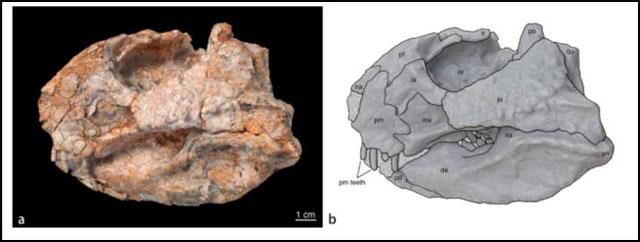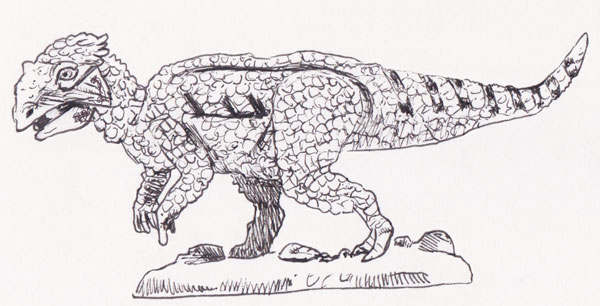A Dinosaur “Begs” to Differ
A Neoceratopsian from Mongolia – Beg tse
A new species of basal neoceratopsian has been described from fossils found near the town of Barunnbayan in the Gobi Desert of Mongolia. The little dinosaur, which was probably less than a metre long, has been named Beg tse in honour of the Himalayan deity Beg-tse. In Mongolian culture, prior to the spread of Buddhism, Beg-tse was a god of war, often depicted as heavily armoured with large, roughened patches on its body. The researchers studying the fossil material noted that, like other members of the Neoceratopsia, Beg had rugosities (roughened areas), on its skull, notably on the jugal and the surangular.
Beg tse – A Newly Described Dinosaur
The Compressed Skull of Beg tse with an Accompanying Line Drawing

Picture credit: Yu et al (Nature)
The Most Basal Neoceratopsian Described to Date
The only known specimen of Beg tse (specimen reference: IGM 100/3652), was discovered by a joint American Museum of Nature/Mongolian Academy of Sciences expedition in 2015. The fossils probably represent a single individual and consist of an articulated partial skull along with postcranial elements consisting of a fragmentary right ischium, a partial left scapula, one rib bone and numerous bone fragments.
A phylogenetic analysis conducted by the scientists, which included Dr Mark Norell (American Museum of Natural History), indicates that Beg is the most basal neoceratopsian dinosaur known to date and is more derived than both the Psittacosauridae and Jurassic Chaoyangsauridae.
A Speculative Life Reconstruction of the Basal Neoceratopsian Beg tse

Picture credit: Everything Dinosaur
Proving Difficult to Date
It is difficult to estimate the date of the fossil bearing strata for many of the Gobi Desert dig sites due to the lack of detailed geological mapping and the limited number of sediments suitable for radiometric dating. The sandstone dominated deposit has been dated to between 113 – 94 million years ago, with a most probable date of circa 100 million years ago. As a result, the researchers conclude that Beg dates from the latest Early Cretaceous or the earliest Late Cretaceous.
The Ceratopsia may have originated around the Middle Jurassic, but the skull of Beg tse exhibits a combination of primitive and more derived traits which suggests that the basic ceratopsian bodyplan persisted until at least the Early-Late Cretaceous boundary. Beg along with other Asian neoceratopsians such as Auroraceratops and Mosaiceratops represent transitional forms between basal ceratopsians and more derived forms. With a wide geographical range from South Korea, China and Mongolia and a long time span from the Aptian to possibly the Campanian, the early evolutionary history of the horned dinosaurs is probably much more complex than previously thought.
The scientific paper: “A neoceratopsian dinosaur from the early Cretaceous of Mongolia and the early evolution of the ceratopsia” by Congyu Yu, Albert Prieto-Marquez, Tsogtbaatar Chinzorig, Zorigt Badamkhatan and Mark Norell published in Nature (Communications Biology).
The Everything Dinosaur website: Everything Dinosaur.

